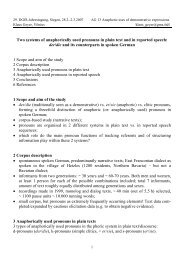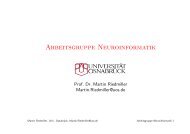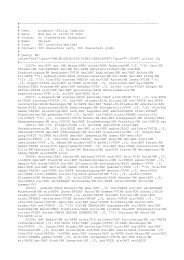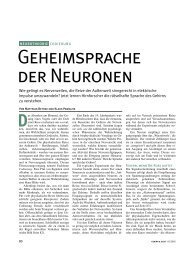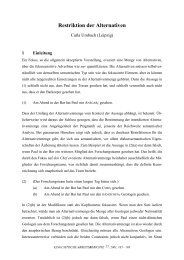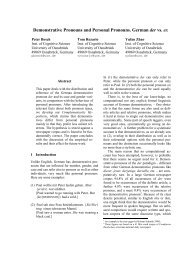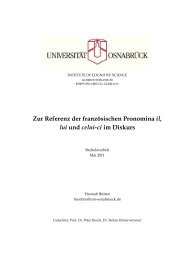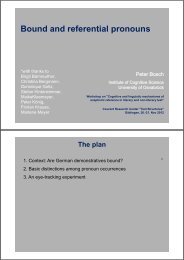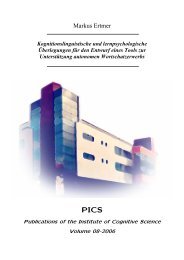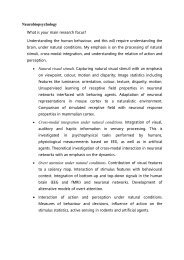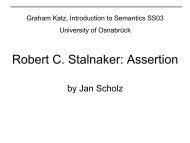Proceedings of the 6th Annual Meeting of the - Heinrich-Heine ...
Proceedings of the 6th Annual Meeting of the - Heinrich-Heine ...
Proceedings of the 6th Annual Meeting of the - Heinrich-Heine ...
Create successful ePaper yourself
Turn your PDF publications into a flip-book with our unique Google optimized e-Paper software.
(7) Plurality is represented via a structured domain <strong>of</strong> individuals; plural objects are formed<br />
by a join operation , and are <strong>of</strong> <strong>the</strong> same type as singular individuals, namely type e.<br />
(Leonard and Goodman 1940)<br />
(8) Plural morphology is interpreted as semantic plurality: plural expressions only include<br />
pluralities in <strong>the</strong>ir extension. (cf. Chierchia 1998)<br />
(9) Coordination can receive a cumulative (plural-forming or “non-Boolean”) interpretation.<br />
(Link 1983; Krifka 1990)<br />
The above claims are defended in Artstein (2001), where <strong>the</strong> argument is made based on <strong>the</strong><br />
behavior <strong>of</strong> coordinate adjectives in languages that mark <strong>the</strong>m with plural morphology. The assumptions<br />
about plurality (7) and (8) state that plural NPs like orthodontists and periodontists<br />
denote sets <strong>of</strong> strictly plural objects.<br />
(10) [[orthodontists]] =λα:α 2 PL ^ α = α1 αn ^8i n[[[orthodontist]](αi)]<br />
[[periodontists]] =λα:α 2 PL ^ α = α1 αn ^8i n[[[periodontist]](αi)]<br />
As for coordination, <strong>the</strong> assumption in (9) states that when and coordinates individuals <strong>of</strong> type e<br />
it can denote <strong>the</strong> join operation on <strong>the</strong> domain <strong>of</strong> individuals .<br />
(11) [[Bill and Martha]] =[[Bill]] [[Martha]]<br />
Cumulative conjunction for common nouns (type et) is defined as follows: an object α is in <strong>the</strong><br />
denotation <strong>of</strong> a coordinate common noun if it is <strong>the</strong> join <strong>of</strong> two objects α1 and α2, whereα1 is<br />
in <strong>the</strong> denotation <strong>of</strong> <strong>the</strong> first conjunct and α2 is in <strong>the</strong> denotation <strong>of</strong> <strong>the</strong> second.<br />
(12) [[orthodontists and periodontists]] =<br />
λα:α = α1 α2 ^ [[orthodontists]](α1) ^ [[periodontists]](α2)<br />
We thus get <strong>the</strong> desired reading for orthodontists and periodontists: <strong>the</strong>re must be at least two<br />
orthodontists and two periodontists in any group denoted by (12); it may be <strong>the</strong> same individuals<br />
who are practitioners <strong>of</strong> both kinds, or different individuals (in <strong>the</strong> latter case <strong>the</strong> size <strong>of</strong> <strong>the</strong> group<br />
is greater than two).<br />
2.2 Phonological decomposition<br />
We now turn to <strong>the</strong> coordinate NP ortho and periodontists. In order to interpret it we must assign<br />
an interpretation to <strong>the</strong> word parts ortho, perio and dontist. I believe that <strong>the</strong> lexical or<br />
etymological meanings <strong>of</strong> <strong>the</strong>se morphemes are largely irrelevant. Many speakers can identify<br />
<strong>the</strong> morpheme ortho in words like orthodontist, orthopedics, orthography and orthodox, without<br />
knowing <strong>the</strong> etymological meaning <strong>of</strong> <strong>the</strong> root and what it contributes to each <strong>of</strong> <strong>the</strong>se words.<br />
What matters, <strong>the</strong>n, is <strong>the</strong> ability to recognize ortho as part <strong>of</strong> a bigger word, whose meaning is<br />
known.<br />
The meanings <strong>of</strong> <strong>the</strong> individual morphemes thus have to be derived from <strong>the</strong> meanings <strong>of</strong> <strong>the</strong><br />
words <strong>the</strong>y form. One possibility would be to treat <strong>the</strong> words orthodontist and periodontist as<br />
idiomatically combining expressions, a term that Nunberg et al. (1994) use for expressions like<br />
pull strings: <strong>the</strong> expression is idiomatic, yet speakers understand each <strong>of</strong> its constituents as making<br />
a distinct contribution to <strong>the</strong> idiomatic meaning. Thus, <strong>the</strong> word strings in <strong>the</strong> expression pull<br />
3



